what is a tool used to figure out how to mix pigments
Adding colour to Encaustic Wax Medium
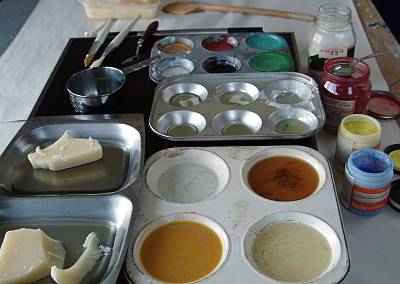
Once y'all take a source of the encaustic wax medium you may want to color it.
This section looks at unproblematic ways to mix paint into molten wax medium.
It is not meant to be definitive nor is it comprehensive, but it is a good introduction for home studio working and hopefully will aid set some useful and practical guidelines.
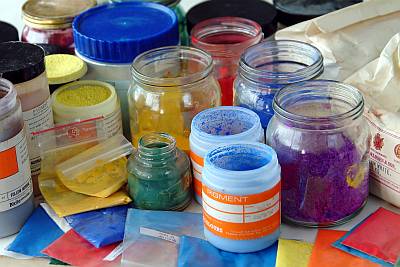
Pigments are basically ground upwardly clay of the desired colour. Materials that become basis upwardly are called not only for the colouration simply as well for their stability - the best ones remain that aforementioned color through long spans of time.
Some are natural, like stone, only others are human being-made...
wikipedia : What is pigment?
Up to Index
Mixing minor amounts of colour into wax using the upturned iron as a mini hotplate
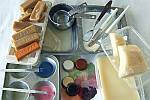
After making your wax medium it will probably demand to exist coloured, usually with finely ground paint particles.
On this page in that location are a few different approaches to colouring varying amounts of previously made encaustic wax medium.
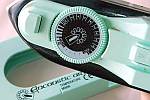
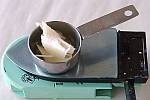
This small stainless steel measuring cup is like a tiny saucepan and works perfectly for this approach to adding colour.
Pause off a modest amount of encaustic wax medium (or melt and pour from a larger vessel) then allow it time to melt - work at low heat.


A modest safe tipped scrapy tool is used here to decant some pigment into the molten wax.
How much pigment and what types you use depend on your choices about the last qualities of colour desired. Translucent or opaque, weak or strong colour, and so on.
Cautions: Pigment can be dusty and some are poisonous, and so accept adequate measures to avoid breathing in any dusty materials.

Place the pigment carefully into the molten medium.
Employ pigment that is milled (ground downwardly) to the particle size you desire. The finer the grit the more fluid the terminal paint and the more even the colour coverage. Some pigments take an optimum particle size offering maximum refraction of light and thus greatest vibrancy of their hue quality.

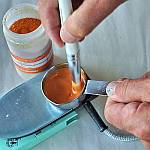
The condom tip used here is ideal for squashing the pigment against the side of the metal container. This activeness helps to moisture all the paint and split up the particles fully so that the color is extended evenly throughout the liquid wax base.
At the end of the mixing give the wax a terminal twirl to ensure all the paint is mobilised inside and throughout the liquid ...




Up to Index
This sample has been torn in half before information technology was too common cold, so that the distribution of pigment can exist noticed.
This is a proficient mixing and the colour is apparent and even throughout the entire wax volume. This is in dissimilarity to separation that occurs when the paint is heavy, the wax is as well deep or too hot when cast.
Adding and Mixing in Larger Apartment Bottomed Containers on the Hotplate
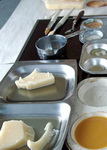
The adjacent step up from minor individual casting of colours is to make a larger batch mix.
For this we have used a hotplate every bit the heating device and on it placed a flat bottomed stainless steel serving dish that has a large heating surface area enabling low temperatures to melt larger quantities of wax easily. Tall vessels are not recommended unless they accept a surrounding heating element (similar the wax melting pot for case).
Annotation: at acme of image at that place are tools laying on the hotplate keeping warm and thus gear up for immediate employ.

A slice of encaustic wax medium is melted onto the metal surface of the stainless steel tray being used as the mixing well.
The wax could just be laid in information technology to melt, only the pressure and motility around the vessel make for faster liquification.

One time sufficient wax is molten some pigment - white in this instance - tin can be added. Think the dust alarm from higher up (cautions).
The amount of pigment added hither is more than necessary, only at this stage information technology is easier to mix evenly into a creamy consistency.




Work through the unabridged surface area of the mixing tray to be sure there are no lumps or dry pigment crumbs left.
When y'all are certain and so further wax can be added.

The pocket-size measuring cups are useful for holding molten encaustic medium set up for calculation to the creamed pigment.
This is a fashion of extending the volume of wax and weakening the paint density. Proportions depend upon your requirements!

Now a hogs hair castor is used to mush and stir the new liquid wax into the creamy pigment paste.
Work thoroughly to create a smooth running liquid paint.
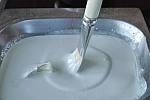



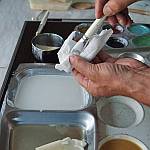
Upwards to Index
... and then clean off the mixing castor. Your white wax paint is now ready to use. It can be left in a mixing tray similar this, and then let to absurd when not in use, or it can be decanted into molds for smaller pieces to exist formed and then reheated or used as necessary.
The key is to ensure an even distribution of pigment through out the mixture. Particles that are too big volition sink. Always stir the wax mix before using the paint. This ensures maximum distribution of even colour.
Baking Can Wells equally Multi-color Palettes

Small amounts of several colours can easily co-addiction a muffin tin palette.
One brush to one colour enables make clean fresh paint to be practical to your artwork.

A niggling amount of encaustic wax medium is first melted into one of the wells of the flat bottomed muffin tray.
The a castor is dabbed into the pigment pot to collect an corporeality of coloured grit, ready for adding to the wax.
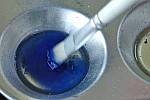


As the new white mixes in the hue changes and the milky opaqueness becomes more credible.
In opaque colour the light will bounce off the surface particles whereas in translucent mixes more calorie-free penetrates the medium depth, creating a glowing quality to the color providing the support is light reflective.

Upward to Alphabetize
The wells of wax pigment remain set up for use with their respective brushes also warmed and ready to hold and apply their load when called.
Palette trays can be created so used and added to advertising infinitum, merely ever stir the wax paint immediately before use.
Direct Hotplate Palette Mixing
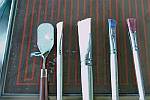

Pour out a small amount of liquid encaustic medium onto the hotplate glass surface. Aluminum hotplates will create a tainted colour due to particles of this soft metallic being eroded by the mixing of the pigment (annoying activeness). Drinking glass is best but stainless steel is ok.
If you don't have a wax pot of vessel of molten wax and so just concur a solid piece against the surface until sufficient is melted off.
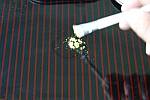
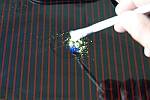
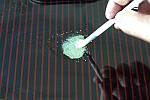

Up to Index
The hotplate surface can hands be cleaned off with tissue whilst warm.
Note: small amounts of wax can evaporate, particularly if the hotplate is set up a scrap high. So too every bit e'er remembering to work with practiced ventilation, notice that you may need to add a fiddling farther wax medium to re-liquify the pigment if information technology has stood for some time.
Carte du jour Palette on Hotplate - for tints, references, pocket-size detailing tones, etc.
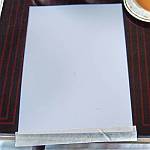
An interesting and very useful alternative to direct wax mixing on the hotplate surface is to create palette cards. These begin life as a piece of not-absorptive menu taped in position on the hotplate surface; and so it stays where you desire it to exist!
An A5 (6"x8") is platonic for pocket-sized arrays of color.
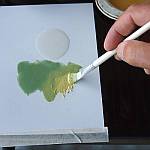
Pour or cook on your plain base encaustic wax medium, and then begin to add colour. The brush hither is dabbed into a pigment, then worked into the wax.
The hue tin can be maintained, lightened or darkened and then on depending on your colour mixing choices.




Then use a tissue and wipe the "dirty" wax out of the brush hairs.
Repeat with clean wax until you are comfortable with the state of cleanliness.

Now that the castor is cleaned a totally new hue tin be mixed without fear of contaminating colour.
Whilst warm and molten the colours can exist utilised from this bill of fare palette at whatever fourth dimension.

Up to Index
Card palettes are very useful for creating a close harmony of tones, for skin colour for example. If a stylus is used to collect and utilize the colours and then the bill of fare demand not be heated.
Card palettes can be kept for years and added to as they are consumed. Why not consider making a range of them for that specific tone to be available and at hand on need.
Muffin or Cakes Tin Molds and Settlement Problems

This deep welled muffin tin can is a bang-up mold and mixing tray for making many colours at one session.
The flat bottomed tray absorbs heat hands from the hotplate.
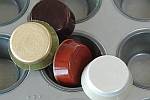
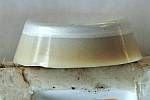
Settlement is a problem that you volition no uncertainty see.
These images testify a range of different pigment particles in wax and the resultant cooled issues. Here a pearlescent mica was used. These particles are large and heavy and have settled out during cooling.
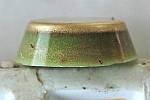

This crimson-chocolate-brown colour is a finer ground pigment and the particles have remained suspended much better. These lighter finer particles of color have not settled so fast. Therefore the distribution is improve.
Of class, if y'all are re-melting the whole piece into a liquid form in order to apply your technical approach then the settlement is non important provided you stir the wax each time to come to use it.

This instance is the all-time of the iv shown here. The paint is fine enough not to accept settled out during the cooling time. The mold is not likewise deep and the wax was non too hot at pouring time.

Up to Index
The moral of the paint settlement story is to:
one) Avert heavy paint particles or mix then until congealing occurs
2) Avoid deep molds that will take a long time to absurd
3) Stir your paint thoroughly earlier pouring
4) Buy well milled pigment optimised for color reflection.
5) Learn from your ain exploration and share the knowledge
| Arts Encaustic Ltd, Glogue, Pembrokeshire SA36 0ED UK |
Source: https://www.encaustic.com/techniq/fineart/fineart_recipes/fineart_recipes_colour.html
0 Response to "what is a tool used to figure out how to mix pigments"
Enviar um comentário